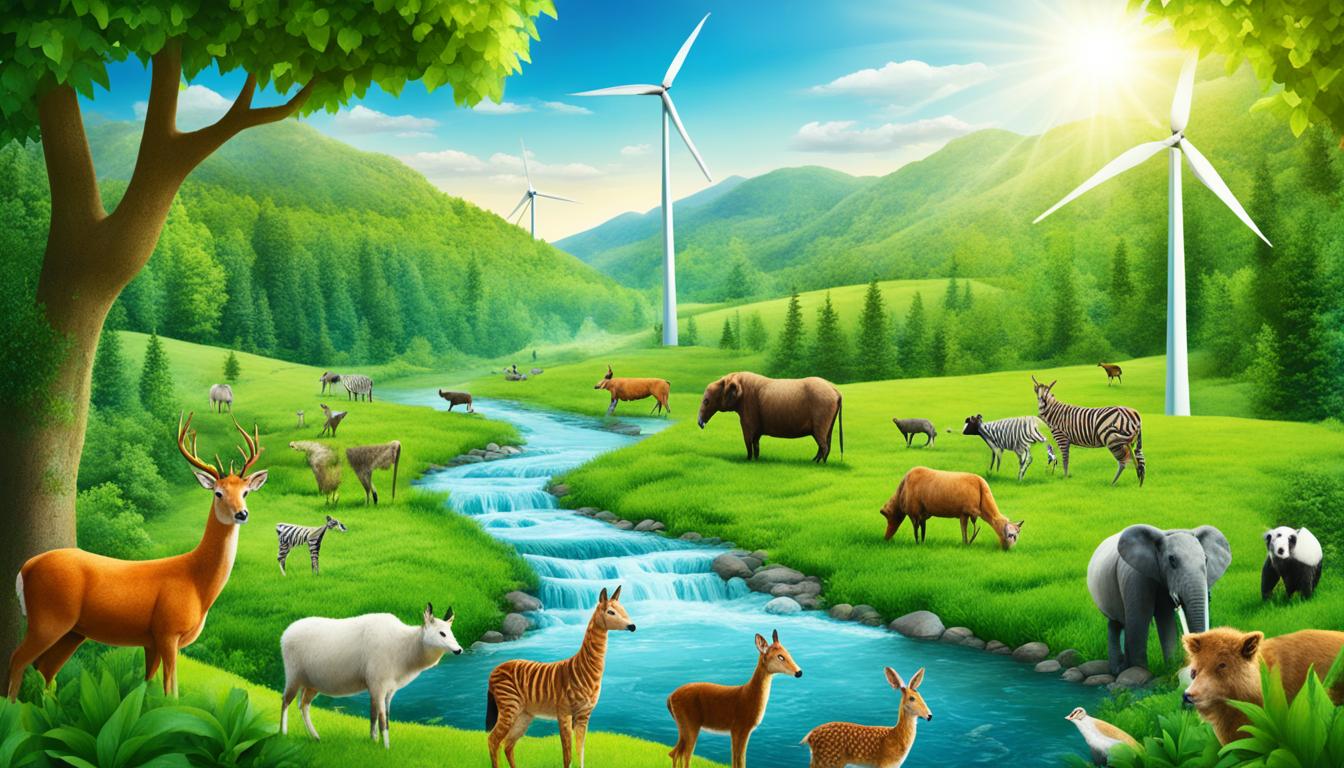Every choice we make affects our environment and Earth’s balance. Our carbon footprint, and the resources we use daily, impact our planet. To lessen this impact, we need to work towards a more sustainable future. This piece will look at ways to adopt sustainable practices and care for the environment. We’ll discuss how to lower your carbon footprint, save resources, use renewable energy, and protect biodiversity1.
Many now see sustainability as a key issue, given our planet’s distress. It’s not just about us, but businesses and governments need to act too1. By making smart choices and starting eco-friendly habits, we all help protect Earth. We ensure we leave enough for future generations to enjoy.
Key Takeaways
- Sustainability is essential for protecting our environment and natural resources.
- Embracing sustainable practices can reduce your carbon footprint and contribute to a cleaner, greener planet.
- Supporting renewable energy sources and conserving natural resources are crucial for a sustainable future.
- Protecting biodiversity and preserving ecosystems are vital for maintaining a healthy, balanced environment.
- Businesses and individuals can make a positive impact by adopting sustainable practices and fostering environmental stewardship.
Understanding the Importance of Sustainability
Our choices greatly affect the environment, leading to climate change and resource depletion2. If we don’t act, ecosystems may be destroyed, and species can disappear. It’s vital to grasp why sustainability matters. This knowledge is key to safeguarding our planet for the future.
Our Impact on the Environment
Businesses are key in facing up to environmental issues2. The World Bank says, saving 10% more energy could boost profits by 1.5%. Furthermore, strong green efforts in firms hike productivity by 16%, shows research from UCLA2. Encouraging green habits in companies not only helps the environment but also makes good economic sense, like saving money on efficient technologies2.
Each person makes a big difference with their daily choices2. Pushing for eco-friendly ways to travel and forming green teams at work are game-changers. These actions lower harmful emissions and inspire creative green solutions within organizations2.
The Consequences of Inaction
Not dealing with environmental issues can be catastrophic3. The IPCC warns, we must curb emissions before 2025 to keep the planet from warming too much. By 2035, we need a 60% cut in emissions, or we face more climate disasters and heavy costs to manage them3.
Ignoring sustainability also hurts businesses and people4. Advanced education helps professionals lead initiatives that find a balance between profit and the planet4. Truly sustainable companies aim to do the least harm to the environment and society. They are essential for reducing negative impacts on nature4.
“Sustainability is not just about the environment, it’s about ensuring a better quality of life for everyone, now and for generations to come.”
Reducing Your Carbon Footprint
Reducing your carbon footprint is key to a better future. Making eco-friendly transportation choices is a big step5.
Eco-Friendly Transportation Choices
There are many ways to travel without harming the planet. Walking, cycling, using public transportation, or carpooling all help5. Switching to electric vehicles also cuts your carbon impact. EVs produce no direct emissions and are kinder to the environment than gas cars5.
There are more changes you can make to lower your carbon footprint. Using LED light bulbs at home is a start. They use less energy and last longer than regular bulbs5.
Also, think about what you eat. Eating fewer animal products and choosing local, organic foods cuts your carbon footprint5. These are helpful steps.
Recycling, composting, and using less plastic all help to lower your footprint6.
Washing clothes in cold water and doing full laundry loads are also good. They save energy and water6.
“Reducing your carbon footprint is not just about the environment – it’s about taking responsibility for your actions and making a positive difference for the future.”
Choosing eco-friendly transport and making your home more efficient are important. So are sustainable food choices. Together, they cut your carbon footprint567.
Conserving Natural Resources
Preserving our planet’s natural resources is key to a sustainable future. Focusing on water conservation and energy efficiency helps cut down our impact on the environment. It also leads us toward a future that ensures resources for all8.
Water Conservation Strategies
Water is precious, and we must use it wisely. By fixing leaks and using water-saving tools like low-flow showerheads, we can save a lot of water. It also helps to turn off the tap when not needed and keep showers short8.
Energy Efficiency at Home
Reducing your home’s energy use is essential for saving natural resources. Swapping to LED bulbs, unplugging devices when not in use, and using energy-efficient appliances can help. Adding natural light, insulating your home well, and setting your thermostat wisely also improve energy use8.
| Water Conservation Strategies | Energy Efficiency Measures |
|---|---|
|
|
Using these water conservation and energy efficiency methods can benefit nature and keep our homes sustainable8910.
“Sustainability is not just about the environment, it’s about ensuring a better quality of life for everyone, now and for generations to come.”
Sustainable Food Choices
The food we eat has a big impact on the earth11. The gases from producing food and using up resources affect our planet. Choosing sustainable foods helps lessen this harm and makes our food system stronger.
Eating less meat, especially red meat, is very important for the earth11. The meat industry causes a lot of greenhouse gas emissions. Shifting to more plant-based meals can cut our carbon footprint and improve our food system.
Choosing organic and local foods is also key to eating sustainably12. These foods are grown with care for the environment. They come from farms that use good practices, leading to healthier food and earth-friendly farming.
It’s vital to cut down on food waste too11. Overfishing is destroying our oceans. Using up or giving away the food we buy helps save resources and protects our environment.
Eating sustainably benefits both the planet and our health12. Foods like fruits, veggies, and whole grains lower the risk of diseases. Grass-fed meat and dairy products are healthier too, with good nutrients.
With nearly 10 billion people to feed by 205011, we need to change how we eat. This means eating more sustainably, wasting less food, and using better farming methods11. These shifts can help build a food system that’s good for us and our earth.
“Sustainable farming promotes fair labor conditions and supports local communities, ensuring that everyone involved in the food production chain receives fair compensation and opportunities for advancement.”12
In the end, choosing sustainable food is crucial for our planet and the people who live on it. By eating less meat, choosing organic and local foods, and not wasting food, we can help the environment. This way, we make sure we have a healthy and fair food system for the future111213.
Embracing Renewable Energy Sources
Working towards a more green future, we see the importance of solar and wind power. These options are gaining more interest. They help cut down our use of fossil fuels and fight against climate change14.
The Rise of Solar and Wind Power
Solar and wind energy use is growing. Solar is now more affordable and available. It is a top choice for homes and businesses15. Wind energy is also reliable. Wind turbines are visible in many places, offering us a green energy solution15.
Moving to solar or wind power has many pluses. It lessens our fossil fuel use. This works towards lowering greenhouse gases and fighting climate change14. Also, it creates many new jobs, more than what traditional energy fields offer16.
Investing in eco-friendly tech saves money in the long run. It also helps the planet. It’s great for saving money and being kind to the earth16. It gives us more control over our energy, lessening our worry about fuel price changes and shortages16.
As we choose renewable energy more, we open doors for new markets. Both new and older companies find chances to grow. The path to using more green energy is hopeful. Supporting solar, wind, and other renewable sources helps us all. It leads to a better, greener future.
“Renewable energy has the power to transform our world, paving the way for a cleaner, more sustainable future.”
Reducing Waste and Promoting Recycling
Sustainable waste management is key to protecting our planet. The issue of plastic pollution is very serious17. Each year, millions of tons of plastic waste end up in our oceans. This damages marine life and ecosystems. To combat this, we must follow the “reduce, reuse, recycle” approach. We need to cut down on single-use plastics as much as possible.
Community recycling programs are essential in reducing waste18. Places like San Francisco and Seattle have seen great success with these efforts18. These programs not only help save landfill space but also create jobs. They boost local economies, too.
Businesses have a role to play in managing waste well19. Good waste management can save money by reusing materials and recycling. It lowers the use of new resources and cuts disposal costs. This way, businesses can also improve public health by reducing pollution.
17 Habitat for Humanity ReStores help lessen waste by selling donated items and materials17. This saves items from ending up in landfills. Also, by providing deconstruction services, they help in saving resources. They offer a way to repurpose building materials, supporting the community.
17 Living sustainably makes a big difference. You can reduce your environmental impact by using green appliances, saving water, and choosing eco-friendly transport. Joining in on recycling and composting can cut down on new resource needs.
17 It’s good to support businesses that care for the environment. Buy products with less packaging and that are made fairly. Also, push for eco-friendly policies and support green groups. Educating people about these issues is very important for our future.
17 Habitat for Humanity of the Charlotte Region has helped over 4,000 families. This shows how community efforts can make a big difference. They provide affordable housing and promote sustainable living.

“The world’s plastic pollution crisis is a symptom of a deeper problem: our linear ‘take, make, waste’ economy. We need to transition to a circular economy, where waste is designed out, and materials are reused and recycled.”
Sustainable Practices and Foster Environmental Stewardship
Protecting our planet means making smart choices every day. We should think about what we buy and how we get around. This helps lower the impact we have on the Earth20. Living and supporting green ways can make the world a better place for everyone.
Many places are showing us how to focus on the environment. The Department of Energy (DOE) has fun activities like Earth Day contests. These events get staff and partners to care more about nature20. The DOE also works hard to use electronics in ways that help save the Earth, not harm it20.
The DOE uses special plans to help make its work more eco-friendly20. It also tries to stop harmful gases from escaping into the air. This shows they really care about keeping our air and planet clean20.
DOE also works to protect birds that fly between places. They follow laws to keep these birds safe all across the country20. The DOE looks after pollinators like bees as well, making sure they have what they need to live and grow20.
Stopping pollution and lowering waste is very important to the DOE. They try to not make waste in the first place and find ways to use things again20. They choose products that are good for the Earth whenever they can20.
DOE gives out awards for sites that are doing a great job of being green. This encourages everyone to care for the environment20. They want to set a good example for others to follow, showing how we can all work together to protect our planet20.
And colleges, like Lebanon Valley College, also play a big role in caring for our Earth. They have goals to keep their campus eco-friendly21. Since 2002, they have been making sure to use nature in a way that saves it for the future21.
This college is making big changes to help the environment. They are using all clean energy and have many programs for sustainable practices22. Their mission is to eventually produce no carbon emissions at all22.
Lebanon Valley College teaches their students the importance of looking after the Earth. They provide classes that prepare people to be leaders in this area22. The school tells everyone how it is doing regarding preserving the Earth and gets the community involved to help out22.
The DOE and colleges like Lebanon Valley College lead the way in caring for our planet. By supporting these efforts, we can all help create a better world. This starts with simple daily actions and supporting policies that protect the environment for the future.
Supporting Green Initiatives
Taking care of our planet begins with our own actions. We should work with local green groups and back eco-friendly projects. This way, we help our areas and work towards a future where the planet can thrive23.
Joining Local Environmental Organizations
Being part of local green groups is a great step in saving our planet. These teams start projects in our communities to tackle big issues like climate change, pollution, and the loss of wildlife24. Joining them lets you use your skills and time to make a real difference from the ground up.
This kind of group usually has lots of ways for you to help, from cleaning up beaches to planting trees. Or you might speak up for eco-friendly rules with the local government. By getting involved, you not only help nature but also meet others who care about the planet like you do24.
| Benefits of Joining Local Environmental Organizations |
|---|
|
Getting really involved with local groups multiplies your positive impact. You become a key player in tackling the earth’s biggest challenges25. Your work can motivate those around you, starting a wave of sustainable living in your community.
“The greatest weapon against climate change is you. Every bit of energy you save, every bit of carbon you keep out of the atmosphere, matters. Act now, act boldly, and help lead the way toward a sustainable future.”
– Former U.S. Vice President Al Gore
You and I can help build a planet that can last. By backing eco-friendly projects and working with local groups, we effect real change and get others to do the same. Let’s be the voice of hope for our planet232425.
Sustainable Fashion and Textiles
The fashion world is facing criticism for its big environmental toll. The making of clothes and the rapid fashion cycle harm the Earth. Yet, people are becoming more aware of the need for eco-friendly fashion and fabrics. This shift is changing what both shoppers and the industry want.
Fast fashion is known for being cheap and quickly changing styles. This type of fashion makes a lot of waste26. It leads to a use-it-once mentality and floods landfills. Sadly, this method wastes a lot of resources and adds to the world’s carbon emissions27.
Sustainable fashion is the opposite. It uses materials that are good for the Earth and doesn’t waste much. You might see clothes being rented or sold again as a way to help the planet28.
Choosing eco-friendly fashion can lighten the fashion industry’s load on our planet28. It meets the demand for clothes that are made and used fairly. This is good for Earth and for the future of fashion28.

The Impact of Fast Fashion
Fast fashion is really bad for the environment26. It uses too much water and leaves a lot of trash. To make a basic t-shirt, it takes about 2,700 liters of water26.
Many fast fashion pieces are worn just a few times then thrown away26. This creates a massive pile of unused clothes. Sadly, only a small portion gets recycled, and the rest hurts our planet26.
We must deal with the problems fast fashion is causing28. Choosing sustainable fashion helps the Earth and pushes for better ways of making and using clothes28.
“The fashion industry is one of the world’s largest polluters, contributing to climate change, water scarcity, and waste. Embracing sustainable fashion is not just a trend, but a necessity for protecting our planet.”
Protecting Biodiversity
Keeping the planet’s ecosystems in balance is vital. At the core of this work is protecting biodiversity. It’s crucial to save different wildlife homes and keep the environment healthy29.
Equitrans, for example, is fighting to save biodiversity. Before they start building, they look hard at species that might be in danger. They use cool technology to find and stay away from these fragile spots29. By lessening short-term problems and stopping long-term harm, they protect areas many animals need to live29.
But saving biodiversity has many tough parts. Think of the huge piles of plastic trash30 or the smog from cars30. Our actions really strain the planet. We need to change how we do things and put the Earth first. This means caring for our environment and using more sustainable methods30.
Preserving Ecosystems and Wildlife Habitats
Rare has worked hard for years to save our planet’s habitats. They’ve joined efforts with folks everywhere to guard important areas and teach them to take care of their surroundings better31. Saving over 30% of the Earth’s lands and waters is huge work. It shows we can do a lot if we come together31.
They’re working hand-in-hand with Indigenous and rural groups. By teaming up, they make sure these groups have the help and knowledge to use their lands well31. This way of working, which values all living things and includes everyone in protecting nature, is key. It helps keep the Earth’s many forms of life thriving31.
“Biodiversity is the foundation of ecosystem services to which human well-being is intimately linked.”29
Every one of us can help save biodiversity. We can live in ways that are good for the Earth, support local efforts, and push for laws that keep our planet safe. If we all do our part and learn to love nature more, we can make a world where life flourishes right alongside us.
Corporate Responsibility and Sustainability Reporting
Businesses are key players in sustainability. It’s vital for them to shoulder the responsibility32. By openly reporting their sustainability efforts, they can show their impact and their plans to cut it down32. This openness can push other companies to do the same, leading to a greener business world and speeding up our journey to a sustainable future.
For a business to stand the test of time, it must set clear goals for protecting the planet. These goals should be smart — specific, measurable, achievable, relevant, and time-bound32. Sustainability work should stretch throughout its supply chain. Working with eco-friendly suppliers can help reduce the company’s overall environmental harm32. Cutting down on energy use is also key. By turning to solar or wind energy, businesses can lower their harmful emissions32.
Talking openly about sustainability efforts builds trust with everyone involved, from customers to employees. It also makes businesses more aware of their impact on the environment32. Applying circular economy methods, such as focusing on product design, reducing waste, and recycling, can have big eco-benefits32.
- 77% of consumers pick companies that care for the planet33.
- 73% of investors look at a company’s environmental record when investing33.
There’s growing proof that being green is good for the wallet, too34. More and more, people prefer to buy from brands that show they care about the environment and society34. When investors put their money down, they’re increasingly thinking about the company’s impact on the world34.
| Sustainability Reporting Benefits | Key Insights |
|---|---|
| Enables organizations to identify, assess, and manage environmental and social risks | 34 |
| Leads to reduced costs through efficient resource use and waste management | 34 |
| Attracts millennials and Gen Z customers willing to spend more for sustainable products and services | 34 |
| Leverages the flexibility and comprehensiveness of the Global Reporting Initiative (GRI) Standards | 34 |
When companies commit to sustainability, big wins follow. They cut down on harm to the earth and enjoy better trust from customers. This trust leads to stronger loyalty and opens doors to new markets323334.
“Sustainability is no longer a nice-to-have, but a must-have for businesses that want to remain competitive and relevant in today’s market.”
Conclusion
Embracing sustainability is crucial for our planet’s future. It’s all about reducing our impact on the earth. This includes using less energy, saving water, and protecting nature35. By doing these things, we make a big positive change.
Each of us can help in different ways. We can pick greener ways to travel and eat. Joining with others and companies to do good also matters. This way, we make the world better for those who come after us3637.
Let’s stay dedicated to caring for our home, Earth. We should waste less, save more, and keep nature safe. This effort will lead to a better, healthier world for everyone353637.
FAQ
How can I reduce my carbon footprint?
What are some effective water conservation strategies?
How can I improve energy efficiency at home?
What are some sustainable food choices I can make?
How can I support the growth of renewable energy?
What can I do to reduce waste and promote recycling?
How can I get involved in promoting sustainability and environmental stewardship?
What are the environmental impacts of the fashion industry, and how can I make sustainable fashion choices?
Why is protecting biodiversity important, and how can I contribute to conservation efforts?
How can businesses drive sustainability efforts?
Source Links
- What is Sustainability? – Clean the World
- Creating a Green Culture: How to Foster Environmental Awareness Among Employees – One More Tree Foundation
- How to achieve environmental sustainability
- Cultivating sustainability in business: The influence of graduate degrees
- 14 Ways to Reduce Your Carbon Footprint
- Tricks & Tips to Reducing Your Family’s Carbon Footprint — Green and Prosperous
- Comprehensive Guide to Reducing Your Business’s Carbon Footprint: Practical Strategies for a Sustainable Future
- Environmental Stewardship and Sustainability
- Environmental Stewardship: A Guide to Sustainable Practices – ESG Research Pro
- Resilience Institute | The Benefits of Environmental Stewardship
- Sustainability
- How to Make Informed Food Choices – Core Nutrition Health and Wellness
- How to Effectively Encourage Sustainable Food Choices: A Mini-Review of Available Evidence
- Embracing Sustainability: Strategies for Businesses to Foster Environmental Responsibility | Accela Marketing
- Integrating Renewable Energy Sources in Healthcare Design — 5BY5 Engineers
- Empowering Sustainable Leadership with Green Tech Innovations
- Ways to Help Reduce Environmental Waste – Habitat Charlotte Region ReStore
- The Social Benefits of Community Recycling Programs
- The Impact Of Effective Waste Management On Community Health And Environment
- Sustainable Environmental Stewardship
- Walla Walla District Environmental Stewardship
- Sustainability Initiatives
- Council Post: The Benefits Of Going Green For Businesses
- Promoting Environmental Stewardship Through Green Campus Initiatives – MakeMyAssignments Blog
- Eco-Conscious Prosperity: Fostering Sustainable Development Aid
- Sustainable Fashion: A Path to Reducing Environmental Impact
- Third UN Fashion and Lifestyle Network Annual Meeting is set to accelerate progress toward Sustainable Development Goals in fashion and lifestyle sectors | UN Office for Partnerships
- Transitioning to sustainable fashion mitigates environmental impact of fast fashion
- Biodiversity and Land Stewardship – Equitrans Corporate Sustainability Report
- How to be an Environmental Steward in Your Neighborhood | TDS
- Protecting Biodiversity
- Corporate Sustainability: Integrating Environmental Responsibility into Business Practices
- Corporate Sustainability Responsibilities – Building a Better Future
- Sustainability reporting: The many advantages for businesses
- Environmental stewardship: A systematic scoping review
- Efforts Towards Environmental Stewardship – KRM Global Blog
- Environmental Stewardship: A Conceptual Review and Analytical Framework – Environmental Management

